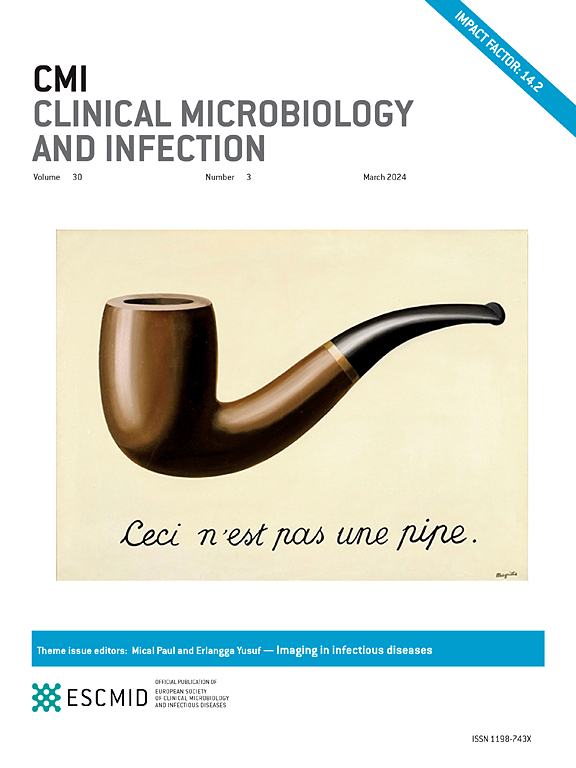血小板与血液感染的死亡率:一项多中心队列研究。
IF 8.5
1区 医学
Q1 INFECTIOUS DISEASES
引用次数: 0
摘要
目的:我们的目的是确定血小板减少症是否与血液感染(BSI)患者的死亡率独立相关,并比较血小板对死亡率的影响与白细胞(wbc)和中性粒细胞的影响。方法:采用两个美国BSI患者队列进行回顾性队列研究:(1)2016年7月1日至2023年6月17日期间德克萨斯州休斯顿大都会地区多医院网络中的患者;(2)公开可用的MIMIC-IV数据库中的患者(2008-2022年)。我们纳入了在采集阳性血培养前48小时内进行血小板检查的患者。我们建立了多变量logistic回归模型,以确定30天住院死亡率是否受到血小板减少程度(严重血小板)的影响。结果:我们纳入了21105例休斯顿队列患者和2710例MIMIC-IV队列患者。休斯顿队列的30天死亡率为12.0%(2524/21105),与血小板计数显著相关。在控制混杂因素后,严重血小板减少症患者30天死亡率的校正优势比(aOR)为4.66 (95% CI 3.91-5.55);中度血小板减少的aOR为2.61 (95% CI 2.25-3.02);轻度血小板减少的aOR为1.55 (95% CI 1.37-1.76),均与正常血小板计数(≥150k /μL)相比。严重血小板减少的校正死亡几率大于中性粒细胞减少、白细胞减少或白细胞增多。在多重敏感性分析和MIMIC-IV队列中,结果相似。结论:血小板减少与BSI患者的死亡率独立相关。血小板计数可以为临床医生提供一种容易获得的方法来对BSI患者进行风险分层,未来的研究应该检查血小板在BSI中起保护作用的机制。本文章由计算机程序翻译,如有差异,请以英文原文为准。
Platelets and mortality in bloodstream infection: a multicenter cohort study
Objective
The objective of this study was to determine whether thrombocytopenia is independently associated with mortality in patients with bloodstream infections (BSIs) and compare the impact of platelets on mortality with that of white blood cells and neutrophils.
Methods
This retrospective cohort study used the following two U.S. cohorts of patients with BSIs: (1) patients at a multihospital network in the metropolitan Houston, Texas, area between July 01, 2016 and June 17, 2023, and (2) patients in the publicly available Medical Information Mart for Intensive Care (MIMIC)-IV database (2008–2022). We included patients who had their platelets checked in the 48 hours before positive blood culture collection. We created multivariable logistic regression models to determine whether 30-day in-hospital mortality was impacted by the degree of thrombocytopenia (severe [platelets <50 k/μL], moderate [50–99 k/μL], mild [100–149 k/μL], and none [≥150 k/μL]).
Results
We included 21105 patients in the Houston cohort and 2710 in the MIMIC-IV cohort, and 30-day mortality in the Houston cohort was 12.0% (2524/21105) and was significantly associated with the platelet count. After controlling for confounders, the adjusted odds ratio (aOR) for 30-day mortality with severe thrombocytopenia was 4.66 (95% CI, 3.91–5.55); aOR for moderate thrombocytopenia was 2.61 (95% CI, 2.25–3.02); and aOR for mild thrombocytopenia was 1.55 (95% CI, 1.37–1.76), all compared with normal platelet counts (≥150 k/μL). The adjusted odds of death with severe thrombocytopenia were greater than those with neutropenia, leukopenia, or leukocytosis. Results were similar in multiple sensitivity analyses and in the MIMIC-IV cohort.
Discussion
Thrombocytopenia was independently associated with mortality among patients with BSIs. Platelet counts can provide clinicians a readily available way to risk-stratify patients with BSI, and future research should examine the mechanisms by which platelets are protective in BSI.
求助全文
通过发布文献求助,成功后即可免费获取论文全文。
去求助
来源期刊
CiteScore
25.30
自引率
2.10%
发文量
441
审稿时长
2-4 weeks
期刊介绍:
Clinical Microbiology and Infection (CMI) is a monthly journal published by the European Society of Clinical Microbiology and Infectious Diseases. It focuses on peer-reviewed papers covering basic and applied research in microbiology, infectious diseases, virology, parasitology, immunology, and epidemiology as they relate to therapy and diagnostics.

 求助内容:
求助内容: 应助结果提醒方式:
应助结果提醒方式:


